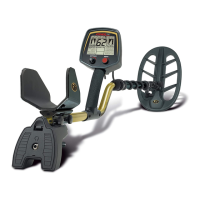Detecting Activities (continued)
Salt Water Hunting
Salt water is highly conductive, and produces a strong signal which is like that of metal.
The F75 is not specifically designed for top performance in salt water, but can be used in
this environment.
If you desire to search in or over salt water, the following measures will usually be
sufficient to silence the salt water response while retaining acceptable sensitivity:
1. Set the sensitivity in both modes to less than 30.
2. Ground balance the machine manually in Motion All Metal mode.
3. Search in the Discrimination mode with a discrimination setting
higher than 25.
HOW METAL DETECTORS WORK
Most hobby metal detectors use VLF Induction Balance technology. Here's how they
work.
The searchcoil (also called search head or loop) contains two electrical induction coils
which are like antennas. One coil transmits a rapidly alternating magnetic field,
illuminating the region surrounding the searchcoil. If metal is present, its electrical
conductivity distorts the magnetic field. If iron metal is present, its magnetism also distorts
the magnetic field, but in a different way, allowing the metal detector to distinguish
between ferrous and nonferrous metals.
The other coil is a receiving antenna which detects changes in the magnetic field caused by
the presence of metal. Electronic circuits amplify this weak signal, analyze it to determine
the changes which occur as the searchcoil sweeps over the target, and then convey the
information to the user in the form of a visual display or audio tones. Most modern metal
detectors perform many of these tasks in software running on an internal microcomputer.
The iron minerals which are present in most soils also distort the magnetic field, obscuring
the weak signals of small or deep objects. This can cause the object to go undetected, or to
be misidentified when it is detected. Much of the technology that goes into modern metal
detectors is devoted to the task of eliminating the unwanted signals from iron minerals in
the soil, while not losing the signals from metal objects.
Copyright Fisher Research Labs, Inc. February 28, 2007

